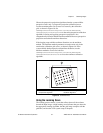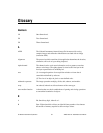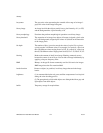Glossary
IMAQ Vision for Visual Basic User Manual G-2 ni.com
barycenter The grayscale value representing the centroid of the range of an image’s
grayscale values in the image histogram.
binary image An image in which the objects usually have a pixel intensity of 1 (or 255)
and the background has a pixel intensity of 0.
binary morphology Functions that perform morphological operations on a binary image.
binary threshold The separation of an image into objects of interest (assigned a pixel value
of 1) and background (assigned pixel values of 0) based on the intensities
of the image pixels.
bit depth The number of bits (n) used to encode the value of a pixel. For a given n,
a pixel can take 2
n
different values. For example, if n equals 8, a pixel can
take 256 different values ranging from 0 to 255. If n equals 16, a pixel can
take 65,536 different values ranging from 0 to 65,535 or –32,768 to 32,767.
blurring Reduces the amount of detail in an image. Blurring commonly occurs
because the camera is out of focus. You can blur an image intentionally by
applying a lowpass frequency filter.
BMP Bitmap. An image file format commonly used for 8-bit and color images.
BMP images have the file extension BMP.
border function Removes objects (or particles) in a binary image that touch the image
border.
brightness (1) A constant added to the red, green, and blue components of a color pixel
during the color decoding process.
(2) The perception by which white objects are distinguished from gray and
light objects from dark objects.
buffer Temporary storage for acquired data.


















